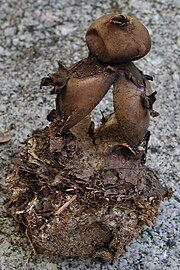|
Geastrum fornicatum
Geastrum fornicatum, commonly known as the acrobatic earthstar or the arched earthstar, is an inedible species of mushroom in the family Geastraceae. Like other earthstar mushrooms, the thick outer skin splits open at maturity, exposing the spore sac to the elements. It is found in the southwest United States. TaxonomyWhen first described in the late 17th century, the species was called Fungus anthropomorphus due to its resemblance to the human figure.[1] In 1799, English naturalist James Sowerby wrote:
The specific epithet fornicatum (Latin for 'arched' or 'vaulted')[3] refers to the arched shape of the rays which extend downwards to rest on the mycelial sac and elevate the spore sac. DescriptionThe immature fruit body is roughly spherical in shape, typically 1–4 centimetres (1⁄2–1+1⁄2 inches) in diameter, and dark brown in color.[4] At maturity, the exoperidium (outer layer) splits into four to five rays which curve backwards so as to elevate the fruit body and raise the spore sac for optimal spore dispersal; the tips of the rays remain attached to a basal cup.[5] The spore sac contains an ostiole, a small opening near the apex. The mature fruiting body may be up to 6 cm (2+1⁄4 in) in diameter and 8 cm (3+1⁄4 in) tall. The exoperidium is attached to the soil by rhizomorphs. The spores are spherical, warted, thick-walled, nonamyloid and 5–6 μm;[6] when young, they are white and firm, but produce a dark-brown color spore print in maturity.[7] Similar speciesSimilar species include Geastrum minimum and Geastrum quadrifidum.[4] Distribution and habitatThe uncommon fungus can be found singly or in small groups in the southwest United States between October and March. It usually grows under bushes and trees in deciduous woods, but not in too deeply wooded areas.[7][8] UsesMethanol extracts of G. fornicatum have been shown to have antimicrobial properties, inhibiting the growth of various bacteria that are pathogenic to humans, including Bacillus subtilis, Escherichia coli, Klebsiella pneumoniae, Pseudomonas aeruginosa, Salmonella typhimurium, and Streptococcus pyogenes, as well as the fungi Candida albicans, Rhodotorula rubra, and Kluyveromyces fragilis.[9] It is inedible.[10] References
External links |
||||||||||||||||||||||||||||||||||||||||||||||

